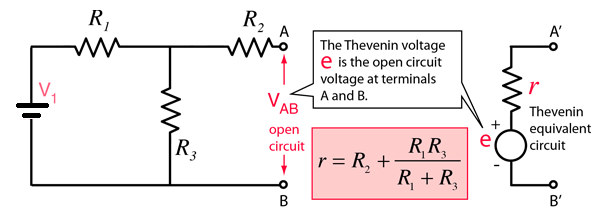 Any two terminal linear network containing energy sources and impedances can be replaced with an equivalent circuit containing a voltage source 'e' in series with an impedance 'z'( in the figure though it is a resistive network 'z' is taken as 'r').
Any two terminal linear network containing energy sources and impedances can be replaced with an equivalent circuit containing a voltage source 'e' in series with an impedance 'z'( in the figure though it is a resistive network 'z' is taken as 'r').
The value of 'e' is the open circuit voltage between the terminals of the network.
And 'z' is the impedance measured between the terminals of the network with all energy sources eliminated( but not their impedances).
Thevenin equivalent circuit is also called the voltage source equivalent circuit. Thevenin equivalent circuit is required to calculate the value of current flow through a resistance in a circuit.
How to Thevenize a given circuit:
- Temporarily remove the resistance( called load resistance [tex]{R_L}[/tex]) whose current is required.
- Find the open circuit voltage [tex]{V_{OC}}[/tex] which appears across the two terminals from where resistance has been removed. It is also called the thevenin voltage [tex]{V_{th}}[/tex].
- Calculate the resistance of the whole network as looked into from these two terminals after all voltage sources has been removed leaving behind there internal resistance (if any) and current sources have been replaced by open_circuit. It is also called thevenin resistance [tex]{R_{th}}[/tex].
- Replace the entire network by a single Thevenin source, whose voltage is [tex]{V_{th}}[/tex] or [tex]{V_{OC}}[/tex] and whose internal resistance is [tex]{R_{th}}[/tex].
- Connect [tex]{R_L}[/tex] back to its terminals from where it was previously removed.
- Finally, calculate the current flowing through [tex]{R_L}[/tex]by using the equation,
[tex]I = \frac{{{V_{th}}}}{{\left( {{R_{th}} + {R_L}} \right)}}[/tex]
- 579 views






